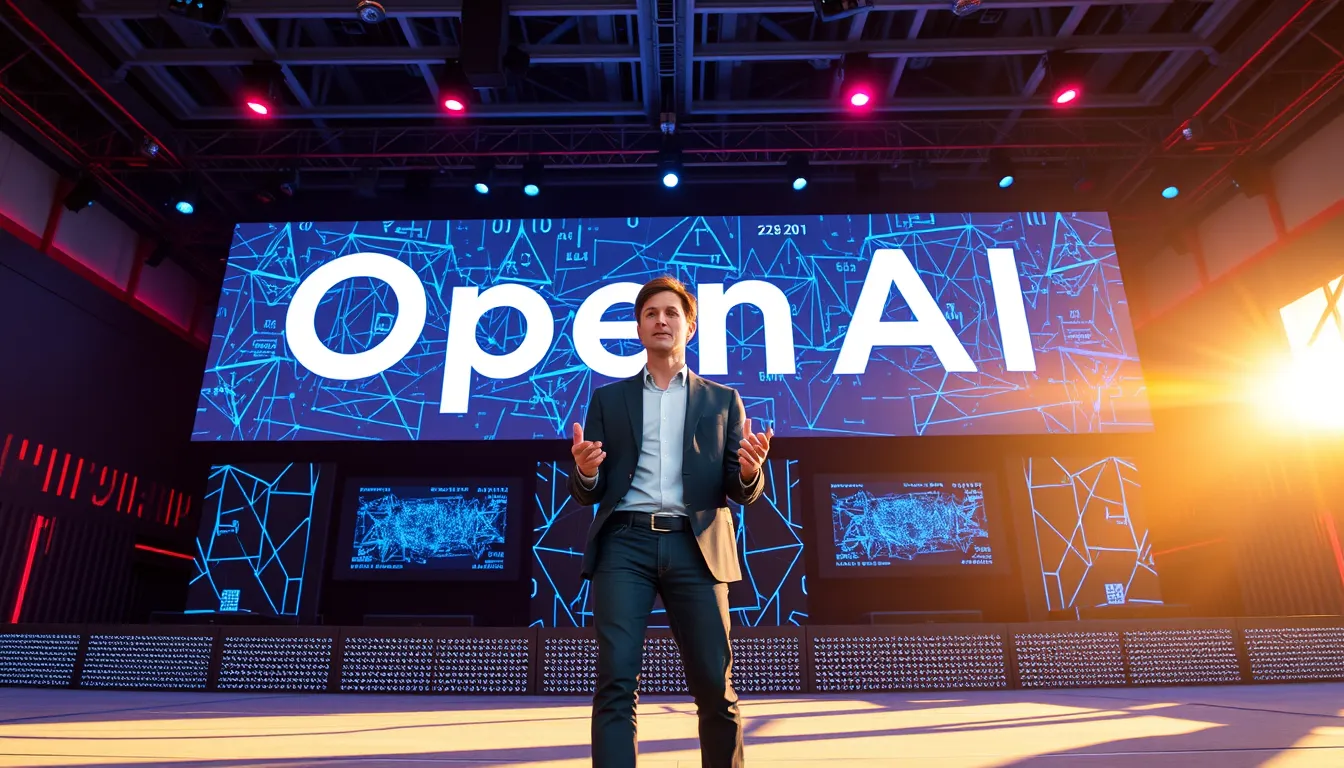Now Reading: OpenAI Open Weight: A New Era of AI Transparency
-
01
OpenAI Open Weight: A New Era of AI Transparency
OpenAI Open Weight: A New Era of AI Transparency

OpenAI Open Weight: A New Era of AI Transparency
Introduction
In a groundbreaking announcement by Sam Altman, CEO of OpenAI, the upcoming release of the OpenAI open weight model marks a transformative milestone in the field of artificial intelligence. This new initiative represents not just a technical advancement, but also a paradigm shift towards greater transparency and collaboration. The release is poised to empower researchers, developers, and the public by providing unprecedented access to the inner workings of advanced AI systems. By opening the model architecture and weights, OpenAI fosters greater understanding and accelerates innovation across several disciplines. In this article, we explore the multiple dimensions of this release, including its key features, benefits to the research community, and broader industry implications.
Key Highlights of the OpenAI open weight Model
- Enhanced transparency and democratization of AI technologies: The initiative is centered on breaking down traditional barriers in AI research, making the technology accessible to a wider audience and catalyzing new developments.
- Boosting innovation through collaborative research: By enabling open access to model weights, the model invites academic and industry experts to explore, modify, and innovate upon this framework, leading to accelerated technological progress.
- Improving AI ethics and reducing bias: With increased scrutiny from a broader community, transparency in AI design and operation helps identify potential ethical issues and biases, ultimately leading to more robust and fair AI systems.
Benefits & Impact on Innovation
The release of the OpenAI open weight model is set to accelerate progress in several critical areas that shape the future of artificial intelligence:
- Empowering Research: Academics, independent researchers, and technology enthusiasts are now given the opportunity to dig deeper into the model’s architectural design. This enhanced access allows for experimental modifications, performance optimizations, and the development of derivative applications. The openness encourages a collaborative spirit, spurring innovative projects across multiple AI subfields such as natural language processing, computer vision, and reinforcement learning.
- Fostering Transparency: Open access to AI model weights paves the way for a new era of collaborative transparency. By enabling external reviews and critiques, the initiative contributes to the refinement of AI ethics and bias mitigation strategies. Researchers can now validate and challenge the assumptions built into these models, ensuring that any inadvertent errors or biases are systematically addressed and corrected.
- Boosting Innovation: The broad availability of a sophisticated AI model like this invites a multitude of creative applications. Developers from startups to established tech giants can leverage this resource to build next-generation AI systems. The ripple effect of such widespread innovation is anticipated to stimulate a dynamic ecosystem where derivative projects will push the boundaries of what is possible with AI technology.
Industry Impact & Sam Altman’s Announcement
Sam Altman’s announcement represents a seminal moment in the ongoing evolution of artificial intelligence. This move underscores a broader shift in the industry towards openness and shared innovation. By publicly unveiling the OpenAI open weight model, OpenAI is not only inviting collaborative experimentation but is also setting a new benchmark for how AI research can be conducted transparently. The decision is expected to influence regulatory frameworks and inspire similar initiatives across the industry, promoting a culture of accountability and continuous improvement.
Technical Considerations
Releasing a model as advanced and complex as the OpenAI open weight comes with a host of technical challenges and strategic considerations. Achieving a balance between protecting intellectual property and providing open access is a delicate task. OpenAI has implemented robust measures to ensure that while the model’s parameters are accessible for scrutiny, its core security features remain uncompromised. This targeted approach helps maintain the integrity of the system while simultaneously inviting the community’s constructive input to improve its performance and ethical standards.
Understanding Transparent AI Models
At its core, a transparent AI model is one that reveals its internal decision-making processes and structural components. This level of openness is critical, especially in scenarios where AI systems make decisions that have significant social or ethical implications. By allowing researchers to evaluate the model’s algorithms and data processing methods, transparency aids in identifying potential weaknesses or biases that arise from training data or algorithm design. For stakeholders, transparency builds trust, as it demystifies the black-box nature of many AI systems which have historically been opaque and difficult to evaluate.
Ethical Considerations and Future Challenges
One of the immediate benefits of releasing the OpenAI open weight model is that it invites public and academic scrutiny, which is essential for identifying and addressing ethical concerns. This open scrutiny is crucial for mitigating issues related to algorithmic bias, fairness, and data privacy. However, with increased transparency also come challenges. There is the potential for misuse or misinterpretation of the data and algorithms. OpenAI, therefore, continues to engage with ethical frameworks and regulatory bodies to craft guidelines that safeguard against potential abuses while encouraging innovation. Looking forward, this initiative could serve as a model for how AI research can responsibly balance openness with accountability.
Navigating Security in Transparent AI
Security considerations are paramount in any discussion about submitting AI models to open review. For the OpenAI open weight model, extensive measures are in place to ensure that while the model weights and architectural details are public, the underlying systems remain secure. The model has been designed with stringent security protocols to prevent unauthorized exploitation. This involves advanced encryption standards and rigorous testing against potential vulnerabilities. Furthermore, by inviting the wider AI community to scrutinize the model’s aspects, OpenAI leverages collective expertise to preemptively identify and mitigate potential security flaws that might not be evident through internal reviews alone.
Community and Collaborative Efforts
The decision to release the OpenAI open weight model openly is a direct appeal to the global community of AI researchers and practitioners. Open collaboration has been the backbone of many significant breakthroughs in technology. With this initiative, OpenAI is essentially laying the foundation for the next wave of innovations where researchers can build upon a shared, robust resource. Numerous academic institutions, independent developers, and corporate research teams are expected to launch new projects that leverage this open model, fostering an environment of rapid experimentation and shared learning. Additionally, community forums and collaborative platforms are likely to flourish as experts converge to discuss findings, share modifications, and push the envelope on what AI can achieve.
Expanding Horizons: The Researcher’s Perspective
From a research standpoint, the open release of the OpenAI open weight model is an invaluable resource. Traditionally, proprietary models have limited the scope for academic research in AI due to access restrictions. The current initiative changes that narrative by providing an open playground where researchers can verify published results, experiment with alternative configurations, and even challenge prevailing theories. This level of access is anticipated to accelerate academic studies in areas such as neural network architecture optimization, computational efficiency, and algorithmic fairness. Moreover, this initiative offers an empirical platform for testing novel AI models and comparing their performance benchmarks against established systems.
Technological and Regulatory Implications
The implications of this open release extend beyond academic and industry research. Regulatory bodies and policymakers are also stakeholders in this development. Transparent access to AI models provides regulators with a clear view into the decision-making processes and safeguards embedded within these systems. Such clarity is essential for crafting informed regulations that promote innovation while ensuring ethical practices. By setting a precedent in open model sharing, OpenAI is potentially influencing standing legal frameworks and contributing to the formation of international guidelines on AI transparency and accountability.
Potential Challenges and Mitigation Strategies
While the benefits of publishing the OpenAI open weight model are numerous, several challenges remain. One major concern is the potential for misinterpretation of the model’s data, which can lead to misguided conclusions or unsound derivative works. There is also the risk that malicious actors could exploit the open data to develop harmful applications. To mitigate these risks, OpenAI has established comprehensive review and feedback mechanisms that involve both the AI research community and independent security experts. This dual-layered approach ensures that any issues are rapidly identified and addressed, maintaining the balance between openness and protection.
Looking Ahead: Collaborative Research and Future Opportunities
As anticipation builds for the summer release of the OpenAI open weight model, the global technology community is bracing for a surge in collaborative research and innovation. The release is expected to spawn a variety of new projects, ranging from academic studies that explore fundamental questions in neural network theory to practical applications that leverage AI for social good. This initiative is a clarion call to researchers to engage more deeply with AI technology, to test innovative hypotheses, and to contribute to a body of shared knowledge that will define the next era of AI development.
Conclusion
The forthcoming launch of the OpenAI open weight model heralds a transformative step for AI research and ethical technology development. By democratizing access to advanced AI systems, OpenAI is not merely releasing a model; it is catalyzing a movement towards greater transparency, collective inquiry, and responsible innovation. The implications are far-reaching—from enhanced research capabilities and improved regulatory oversight to a broader societal understanding of AI ethics and security. As the summer release approaches, anticipation continues to build. Researchers, developers, and policymakers alike await the revolutionary impact this initiative will have on driving AI forward, ensuring that the next generation of technology is as innovative as it is responsible.
For further insights and ongoing updates, visit the OpenAI official website. Additional resources and expert analyses are also being made available on various platforms, providing continuous education and dialogue around these cutting-edge developments.
Additional Resources and Further Reading
To support the transition towards an open and transparent AI ecosystem, numerous publications, research papers, and technical guidelines are available. These documents cover topics such as:
- Best Practices in Model Transparency: Detailed guides on how to conduct rigorous audits of AI systems.
- Ethical AI Frameworks: Publications outlining strategies to mitigate algorithmic bias and ensure fairness.
- Security Protocols for Open Models: Technical papers discussing encryption, vulnerability testing, and advanced cybersecurity methods.
- Case Studies in Collaborative AI Research: Analyses of previous successful open-source initiatives that have led to breakthrough innovations in the field.
These resources are crucial for anyone looking to understand the full context and technical details behind such an expansive initiative. The comprehensive availability of these materials reinforces the overall mission of fostering collaborative ecosystems and nurturing a community of informed and responsible AI practitioners.
Final Thoughts
In summary, the OpenAI open weight initiative encapsulates OpenAI’s commitment to advancing technology through openness and shared innovation. It sets a new standard for how ideas can be collectively refined and applied, turning potential challenges into opportunities for development. As we stand on the brink of this new era, it is clear that the journey towards fully transparent and ethical AI is well underway. Stakeholders across the board—be they researchers, developers, policymakers, or the general public—have a pivotal role to play in shaping this future.
Explore further details by visiting trusted sources and staying engaged with the latest research. The evolution of AI represents a collective endeavor to rethink and reshape the limits of technology, ensuring it benefits society as a whole. With initiatives like the OpenAI open weight model, the future of AI innovation is not simply in the hands of a select few, but rather in the collaborative potential of the global community.
By embracing transparency and sharing knowledge openly, OpenAI is not only building a more robust AI community but also ensuring that the pursuit of excellence in artificial intelligence remains a shared journey toward a better, more informed future.
Ultimately, the release of the OpenAI open weight model is a forward-thinking step that exemplifies how the convergence of technology, ethics, and collaboration can lead to significant breakthroughs and a more equitable technological landscape. As the initiative continues to evolve, it will undoubtedly pave the way for further innovations and a deeper understanding of artificial intelligence that benefits all of society.

























